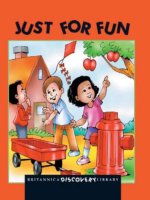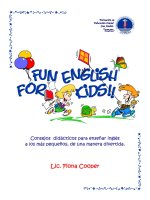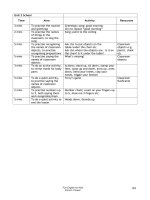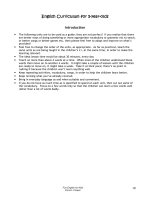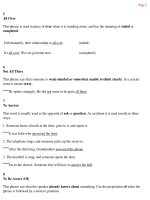Story Fun for Movers
Bạn đang xem bản rút gọn của tài liệu. Xem và tải ngay bản đầy đủ của tài liệu tại đây (1.38 MB, 16 trang )
Karen Saxby
Sample story, activities
and teacher’s notes
Sample story, activities
and teacher’s notes
PHOTOCOPIABLE © Cambridge University Press 2011
C
o
n
t
e
n
t
s
Story: What’s that? 3
Activity pages 7
Teacher’s notes 11
2
Tom’s cousin, Peter, often came to Tom’s house and played with
him. Both boys liked playing basketball and computer games. One
morning, Peter phoned Tom and said, ‘I want to play a computer
game today. Grandma gave it to me yesterday. It’s called “Camping
in the jungle”. First you choose things to take with you. Then you
have to find your tent in the jungle. You jump in rivers, climb tall
trees and see all kinds of jungle animals. Some of the animals are
friendly, and some of them aren’t friendly! Do you want to play it
too?’
‘Yes! Let’s play it this afternoon!’ Tom answered.
Peter brought the computer game to Tom’s house. The boys enjoyed
playing it a lot! They laughed and laughed.
After the game they wanted to get
a drink from the kitchen. Tom’s dad
was there. ‘Hello, boys! I’m making
some pasta for dinner. Was the
game good?’ he asked.
‘It was great,’ Tom answered. ‘I’ve
got a good idea! Let’s camp in the
garden in our old tent tonight! Can
Peter and I do that, Dad?’
W
h
a
t
’
s
t
h
a
t
?
PHOTOCOPIABLE © Cambridge University Press 201133
PHOTOCOPIABLE © Cambridge University Press 2011
‘Yes,’ Tom’s dad said. ‘My old tent’s in the cupboard under the stairs.
Go and get it. And there are some blankets in the basement. Go and
get those too.’
‘Can we have a torch too?’ Peter asked.
‘Yes. There’s one in the car. Go and get it,’ Tom’s dad said.
The boys found the tent, the blankets and the torch and carried
them outside.
When the tent was up, they sat inside it.
‘This is really exciting!’ Peter said. ‘Let’s go to bed now!’
Tom laughed. ‘No! I’m hungry! Let’s have dinner first. Dad makes
great pasta! Come on!’
After dinner, Tom and Peter went outside and crawled into the tent.
Tom’s parents went with them.
‘Have you got the torch and your water bottles?’ Tom’s dad asked.
‘Errmmm yes!’
‘OK! See you in the
morning, then!’ Tom’s
mum said. ‘Good night!
Sleep well!’
‘Thanks! Good night!’
the boys called.
But Tom and Peter
couldn’t sleep!
W
h
a
t
’
s
t
h
a
t
?
Good night!
4
PHOTOCOPIABLE © Cambridge University Press 2011
‘What’s that?’ asked Tom.
‘It’s only the moon,’ answered Peter. ‘Oh! What’s that?
‘It’s only the cat that lives next door, I think,’ Tom said. ‘But what’s
that? Look! By our feet!’
‘It’s only the water bottles,’ Peter answered. ‘Sshhh!’
‘What’s the matter?’ Tom asked.
‘There’s someone or something in the garden. Listen! It’s getting
louder and louder!’
They sat up. Both boys thought about all the jungle animals in the
computer game. They were very afraid.
‘Who’s there?’ they shouted.
‘It’s only me!’ called Tom’s dad. ‘Are you all right?’
‘We are now!’ Tom said.
‘But we can’t sleep!’ Peter said.
‘Well, I always liked sleeping in this old tent,’ said Tom’s father. ‘Can
I sleep in it too tonight?’
‘Yes!’ laughed Tom and Peter. ‘That’s a very good idea!’
What’s that?
5
PHOTOCOPIABLE © Cambridge University Press 2011
Tom’s dad crawled in the tent and got
under one of the blankets, but then he
sat up again quickly.
‘What’s the matter, Dad?’ Tom asked.
‘Are you cold? Are you thirsty?’
‘No,’ his father answered. ‘Listen!
What’s that?’
‘Don’t be afraid! It’s only the wind!’
Peter laughed.
‘And sshhh! What’s that?’ Tom’s father asked.
‘It’s only the goats in the field, Dad!’ Tom laughed. ‘Go to sleep!’
When they woke up in the morning, Peter, Tom and his father
crawled out of the tent and walked back to the house.
Tom’s mum was in the kitchen. She had a cup of coffee in her hands.
‘Hello! Did you sleep well?’ she asked them.
‘Yes, but my back hurts!’ Tom’s dad said.
‘And you? Are you OK?’ she asked the boys.
‘Yes, but it was difficult to sleep,’ Peter said. ‘We were afraid! The
moon was really big. A cat came into the garden too.’
‘And Dad was afraid of the wind and the goats!’ Tom said. ‘But we
had lots of fun too!’
Mum laughed. ‘Well, that’s good!’ she said. ‘Now, let’s have some
breakfast!’
We had lots of fun!
My back hurts!
We had lots of fun!
6
PHOTOCOPIABLE © Cambridge University Press 2011
W
h
a
t
’
s
t
h
a
t
?
New words for you!
Look at the picture and at the words. Draw lines.
Which word is right?
Cross out the wrong words.
Example: Tom’s cousin is called Paul/Peter.
1 The boys liked playing computer games/football.
2 Tom wanted to camp/run in the garden.
3 The boys had pasta/tomato soup for dinner.
4 Tom’s mother/father came to sleep in the tent with the boys.
5 It was easy/difficult for the boys to sleep.
6 The next day, Tom’s dad’s back/leg hurt.
Which is first?
Look at the pictures and write numbers 2–6 in the stars.
A
B
C
1
A B C
D E F
7
PHOTOCOPIABLE © Cambridge University Press 2011
Listening 2
Camping in the jungle
Listen and colour five things in the computer game picture.
Listening 3
What do you want to do?
Listen and tick the box.
1 What does Tom want to 2 What does Peter want
do now? to do now?
A
B
C
A
B
C
3 What does Jane want to 4 What does Mary want
do now? to do now?
A
B
C
A
B
C
D
E
8
PHOTOCOPIABLE © Cambridge University Press 2011
What’s the matter?
Find the differences.
Look at the picture on page 5 and at this picture.
Find 6 differences.
Listening 4
What’s the matter?
What did Tom’s friends say? Choose words from the box.
‘I’m
hungry
,’ Jane said. ‘And I’m ,’ Sally said.
‘Well, I’m
,’ Fred said. ‘I’m ,’ Daisy said.
And I’m very
, ’ Vicky said.
What’s that?
Look at the pictures and write the answers.
F
G
H
tired cold hungry
afraid thirsty
What’s that?
9
PHOTOCOPIABLE © Cambridge University Press 2011
Peter’s email to his parents
Choose words to complete the email.
Hi Mum and Dad,
I’m having lots of
fun
at Tom’s house. Last night, we camped
outside in Uncle Ben’s (1) tent. But we couldn’t sleep
because the moon looked very big and because there was a loud cat in
the garden. We said, ‘What’s that? What’s that?’ It was funny but we were
(2) too.
Then Uncle Ben (3)
outside and crawled in the tent. The
(4) and the goats were very loud. He asked, ‘What’s that?
What’s that?’ too!
This morning, when we all woke up, Aunt Sally made us a very nice
(5)
. I was hungry! Let’s buy a tent too! Can we? Please!
Love
Peter
fun came breakfast field
afraid wind slept old
We want to go on holiday!
Draw a holiday picture in your group.
You can camp in the countryside, on the beach or in the mountains.
You choose.
What do you want to do there?
What do you want to take there?
I
J
10
W
h
a
t
’
s
t
h
a
t
?
11 PHOTOCOPIABLE © Cambridge University Press 2011
Say: Now let’s look at the pictures and listen to the
story.
Listening 1
Play Track 1 or read the story.
Suggestions for two pauses if required:
l Stop the CD after ‘Dad makes great pasta! Come on!’
on page 4 of the story.
Ask: What was the name of Peter’s computer game?
(Camping in the jungle)
Where did the boys want to camp? (in the garden)
Was the tent old or new? (old)
Which things did they put in the tent? (blankets,
torch)
l Stop the CD after ‘It’s getting louder and louder!’ on
page 5 of the story.
Ask: Where were the boys? (in the tent)
Could they sleep? (no)
Were they afraid? (yes!)
Who or what was in the garden? (learners guess)
After listening to the whole story
l Ask: Did the boys enjoy their night in the tent? (yes/no)
Was Tom’s dad afraid of the wind and the goats?
What do you think? (learners decide)
What are you afraid of at night? (learners answer)
B
Which word is right?
l Learners look at the example. Ask: Why is there a line
through ‘Paul’? (Because that’s wrong. Tom’s cousin is
called Peter.)
l Learners read sentences 1–6 and, in pairs, choose the
right answer, crossing out the wrong one. Tell them to
use a pencil. They will want to change their answers if
they are incorrect.
Check answers:
1 computer games 2 camp 3 pasta 4 father 5 difficult
6 back
l Practise Part 4 of the Speaking Test. Write the questions
below on the board. Ask one or two learners the
questions in open class, and then learners practise
asking and answering the questions in closed pairs.
What do you like eating? Who cooks in your family?
Where do you eat at home? Three or four learners tell
the class what their partner likes eating.
Extension for stronger groups:
In pairs, learners look back at the story and write their own
four short right/wrong sentences. For example: Tom is Peter’s
brother/cousin. The tent was in the garden/park. There were some
cows/goats in the story. Tom’s dad/mum was afraid.
Pairs then give their right/wrong sentences to another pair,
who choose the right answers.
Main topics:
hobbies, home, animals
Main grammar:
verb + infinitive: E
What’s the matter?: G
Test practice:
Reading and Writing Part 1: H; Part 4: I
Listening Part 4: E; Part 5: D
Speaking Part 1: F; Part 4: B
Flyers words:
camp (v), friendly (adj), fun (n), into (prep),
tent (n), torch (n)
Non-YLE words:
crawl (v), really (adv)
Equipment:
l Audio: Story, D, E, G
l a torch, pictures of a tent, people
camping and a baby crawling: A
l colouring pencils: D
l photocopies (one per pair), cut into
cards, of ‘What’s that?’ (p 15): H
A
New words for you!
l With books closed, introduce the topic of the story by
asking learners about their hobbies. Ask: What do you
like doing inside your house with your friends? Do you
like playing computer games? What do you like doing
outside with your friends? Do you like playing in the
park? Say: This story is about two boys. Their names are
Tom and Peter. They like playing basketball outside and
computer games inside.
l Teach/revise tent, camp, crawl and torch. Check and
drill pronunciation for each word. Draw a picture of a
tent on the board. Ask: Can people sleep inside a tent?
(yes) Say:When people sleep inside a tent, they are
camping. If possible, show a picture of people camping.
Ask: Where can people camp? (on the beach, in the
countryside, in the jungle) Say: Some tents are very
small. You can’t walk inside a small tent. You have to
crawl. Show a picture of a baby crawling or the picture
in Activity A. Show the torch or a picture of one. Mime
holding a torch to see in the dark. Ask: When do you use
a torch? At night? (yes)
l Learners open their books. They look at the example
and at the line which joins the word tent to its picture.
In pairs, learners decide how to join the other words and
pictures. Check that learners have done this correctly by
asking questions: What colour is the tent? (blue) What
colour is the torch? (yellow) Who’s crawling? (the baby)
Who’s camping? (the two girls)
Storytelling
Before listening
l Learners look at the first picture in the story.
Ask: How many boys can you see? (two)
What are they doing? (playing a computer game /
playing on the computer)
Are they inside or outside? (inside)
How old are they? (learners guess: nine or ten)
12
PHOTOCOPIABLE © Cambridge University Press 2011
Test tip:
In Part 5 of the Listening Test at Movers, learners are given
the mark simply for identifying the object and showing which
colour to use. They are not expected to complete the
colouring.
Tapescript:
Look at the picture. Listen and colour.There is one example.
Man: Can you colour some of this picture for me?
Girl: Yes, I can.
Man: Great! Colour the smaller tent. Colour the
smaller tent purple.
Girl: OK!
Can you see the small purple tent? This is an example. Now
you listen and colour.
One
Girl: Can I colour the moon too?
Man: Yes, you can. Colour it pink, please.
Girl: All right. I’m colouring the moon now.
Man: Great!
Two
Man: Now colour the water bottle.
Girl: Shall I make the water bottle green?
Man: Yes, you can make it that colour.
Girl: Thanks!
Three
Girl: Can I colour the blanket too? The one on the
chair?
Man: Yes. Colour the blanket. Colour it blue.
Girl: All right. There!
Man: Good!
Four
Man: Now colour the monkey’s face. Can you see it?
Girl: Yes, I can. I like the monkey’s face!
Man: Me too! Colour it brown.
Girl: OK.
Five
Man: And colour the parrot now, please.
Girl: OK! I want to colour the parrot with my
orange pencil. Is that OK?
Man: Yes.
Girl: Great! There!
Man: Well done!
C
Which is first?
l Learners find the picture with the number 1 next to it.
Say: This is the first picture. Ask: What’s Peter doing?
(phoning Tom)
l In pairs, learners look at the other pictures and write the
numbers 2–6 in the stars to show the correct order.
l As you check the answers, ask pairs to say what people
are doing in each picture. That way the class is retelling
the story.
Check answers:
B 2 Tom’s playing on the computer.
E 3 Tom’s getting the tent.
C 4 Tom’s in the tent.
F 5 Tom’s afraid.
A 6 Tom’s dad is coming in the tent.
D
Listening 2
Camping in the
jungle
l Ask: Do you play computer games? If learners do,
ask more questions: When do you play? Where do you
play? Who do you play with? What’s your favourite
game called? Ask: What was the name of Peter’s game?
(Camping in the jungle)
l Learners look at the computer game picture. Ask: How
many tents are there? (two) What’s in the river?
(a crocodile) Is the chair inside the tent or outside the
tent? (outside) Can you see an animal’s face in the
leaves? What is it? (a monkey) What’s in the bottle?
What do you think? (learners guess)
If you prefer, write the questions on the board. In pairs,
learners find the answers. Pairs then tell others in the
class what the answers are.
l Check that learners each have a set of colouring pencils.
Say: There is an example. After the example, listen and
colour five more things in the picture.
l Play Track 2 twice.
l Give learners time to finish colouring the five objects.
Check answers:
moon – pink; water bottle – green; blanket on chair – blue;
monkey’s face – brown; parrot – orange
Extension:
Give learners further colouring instructions. Speak slowly,
allowing about ten seconds between each colouring
instruction. Repeat the instructions before checking answers.
Say:
Colour the crocodile’s teeth yellow. Colour the flower red. Colour the
rock in the river black. Make the bigger tent purple too.
Learners could then colour the rest of the drawing with their
own choice of colours.
13 PHOTOCOPIABLE © Cambridge University Press 2011
F
Find the differences.
l Learners look at the picture on page 5. Ask:Where are
the boys? (in the tent) Are the boys sleeping? (no) Which
boy is talking? (Tom) What’s he saying? (What’s that?)
l Learners also look at the picture in the activity. Say:
Some things in the pictures are different. In this picture
(point to the picture on page 5) there’s one shoe. But in
this picture (point to the picture on page 9) there are … ?
(two shoes)
l Write this model on the board on two lines.
In this picture there’s one shoe,
but in this picture there are two shoes.
Leave this on the board.
l Practise talking about one more difference. Ask an open
pair to complete another sentence: In this picture there’s
a cat, but in this picture there’s …? (no cat)
l In pairs or small groups, learners find four other
differences and think how to describe them. Walk round,
helping with language if necessary. Groups take turns to
tell the class one difference.
Check answers:
The blankets are orange/purple. The socks are between the
water bottles / on the book. The moon is pink/yellow. Tom’s
wearing a T-shirt/sweater.
l Learners close their books. Make sure learners have
their colouring pencils and give each pair or small group
a large piece of paper. Ask one learner in each pair or
group to draw six big boxes on their sheet of paper.
Another learner divides each box diagonally into two
parts. Show learners how to do this on the board:
l Pairs or groups now draw the differences that they
remember on the paper. You can point to the example In
this picture there’s one shoe, etc. on the board. Learners
draw one shoe in one part of the square and two shoes in
the other part to show this difference.
l Learners talk and draw together the other five
differences as quickly as they can.
l Teach/revise drew. Draw a shoe on the board. Point
and say: I drew this shoe. Ask different pairs or groups:
What did you draw? (e.g. We drew a purple blanket and
an orange blanket.)
G
Listening 4
What’s the matter?
l Play Track 4. Ask: Why did Tom ask Peter ‘What’s the
matter?’ (Peter was afraid.)
l Teach/revise What’s the matter? Say: We don’t ask
this question when someone looks happy. We ask this
question when someone doesn’t look happy. Look at
my face. Do I look happy? (no) Ask me, ‘What’s the
matter?’ Mime different feelings such as cold, tired,
bored, sad. Each time you change your expression,
learners ask in chorus: What’s the matter? Answer: I’m
cold, I’m tired, I’m bored, I’m sad, respectively.
E
Listening 3
What do you
want to do?
l Ask different learners: What do you want to do now?
Prompt learners if they can’t think of their own answers.
Ask: Do you want to play basketball? Do you want to
do a drawing? Do you want to read a story?
l In groups of three or four, learners ask and answer the
same question.
l In open class, groups report back on what they want to
do, and what others in the group want to do, using He/
she wants to.
l Say: Now listen to Tom, Peter and some other people.
Tom’s talking to his father. Peter’s talking to his mother.
Tom’s talking to his friend Jane. Peter’s talking to his
friend Mary. Look at the pictures. What do Tom, Peter,
Jane and Mary want to do?
l Play Track 3. Learners tick the A, B or C boxes.
Check answers:
1 A 2 B 3 A 4 C
l Ask: Do you want to sleep now? Do you want to play
with this cat too? Do you want to climb a tree? Do you
want to listen to music?
Homework idea:
Learners write five complete sentences about things that
they, a friend or a member of their family wants to do today.
Tapescript:
Listen and tick the box.
One What does Tom want to do now?
Tom’s dad: Do you want to have your dinner now,
Tom?
Tom: No thanks, Dad. I’m not hungry and I
don’t want to play on the computer.
Tom’s dad: OK. What do you want to do then?
Tom: I want to sleep in the tent!
Two What does Peter want to do now?
Peter’s mum: Do you want to go for a swim, Peter?
Peter: No, Mum. I want to play with the cat!
Peter’s mum: Oh! All right! And are you thirsty?
Peter: No. I’m fine, thanks.
Three What does Jane want to do now?
Tom: Hello, Jane! Do you want to watch
a DVD?
Jane: Not now, Tom. I want to go outside.
Tom: Well, do you want to play table tennis?
Jane: No. I want to climb that tree.
Four What does Mary want to do now?
Peter: Let’s go for a bike ride, Mary!
Mary: No, Peter. I want to listen to this music.
Peter: Oh! How about a game of football?
Mary: No! Sshhh, Peter! Please be quiet!
14
PHOTOCOPIABLE © Cambridge University Press 2011
l Look at the example together. In pairs or on their own,
learners choose words for spaces 1–5 and write them on
the dotted lines. Note that two answers are not used, as
in Part 4 of the Reading and Writing Test.
Check answers:
1 old 2 afraid 3 came 4 wind 5 breakfast
l Ask: What did you have for breakfast this morning?
Learners tell each other in pairs. Ask two or three
learners to tell the class what they or their partner had
for breakfast.
J
We want to go on holiday!
l Divide the class into groups of three or four. Give each
group a large sheet of paper and make sure they all have
colouring pencils.
l Each group decides where they want to go on holiday.
Ask: Do you want to go to the countryside, to the
beach or to the mountains? At the top of their sheet of
paper, one learner in each group then writes a title. For
example: We want to go to the countryside! We want
to go to the beach! We want to go to the mountains!
(according to their choice).
l If necessary, ask learners to tell you some words for
activities and possessions first. Ask: What do you want
to do on the beach? (swim) What do you want to take
to the beach? (a football) Write their suggestions on the
board under the heading beach.
l Learners read the two questions. Ask one or two
learners for more ideas and write these on the board too,
beginning with I want to. For example: I want to swim
with dolphins. I want to take my comics. Learners then
work in their groups, making more suggestions.
l Say: Draw you and your friends or families doing
these things. Draw the things you want to take on your
camping holiday too.
l At the end of the activity, ask groups to hold up their
holiday pictures and talk about what they want to do on
holiday and what they want to take on holiday.
l Stronger groups:
Learners complete the following email to their parents
about a night on their own camping holiday.
I’m having lots of fun.
Last night, we camped .We couldn’t sleep
because .There was a loud
in the .This morning, when we all woke
up, . See you!
l In pairs, learners ask and answer What’s the matter?
Encourage learners to mime looking tired, sad, etc.
l Learners now look at Tom and his five friends. Say:
Tom’s asking his friends, ‘What’s the matter?
’ What do
his friends say?
l On their own or in pairs, learners decide on their
answers and write one word from the box in each gap.
Note: all these adjectives appear in the story.
Check answers:
Jane – hungry; Sally – afraid; Fred – tired; Daisy – thirsty;
Vicky – cold
Homework idea:
At the top of a piece of paper, learners write What’s the
matter? From old magazines, learners cut out faces that show
sad, angry, etc. expressions and glue them under the question.
They then draw their own speech bubbles for each face,
saying: I’m OK, I’m tired, I’m ill, I’m hot, I’m bored, etc.
H
What’s that?
l Point to a few different singular objects in the classroom
and ask: What’s that? Learners answer.
l Give each pair of learners a photocopy of ‘What’s that?’
(p 15).
l Look at the example together. Ask one learner to read
the definition out loud. Say: What’s that? Find the
picture! The class points to the picture of the tent and
looks at the answer on the dotted line. Pairs continue
looking at definitions, find the answers and write them
on the dotted lines. The pair that completes the activity
first wins.
l In small groups, learners choose one object they can see
in the classroom. They shouldn’t let the class know what
they’ve chosen. They think of sentences to describe the
object. For example: It’s brown. It has four legs. You sit
on it. They read out the sentences and the other groups
guess what the object is.
Check answers:
1 (the) grass 2 (a) sweater 3 (a) computer 4 (a) car
5 stairs 6 (the) moon 7 (the) basement 8 (a) cat
9 (a) cup 10 (our) feet 11 (a) goat
I
Peter’s email to his parents
l Learners look at Peter’s email. Ask: What’s this? (an
email) Learners read Peter’s email to his parents without
writing the missing words in the spaces. Ask: In the
story, who is Peter? Is he Tom’s brother or Tom’s cousin?
(Tom’s cousin) Who are Ben and Sally in this email? Are
they Tom’s uncle and aunt? (No, they’re his mum and
dad / parents.) Read the end of Peter’s email. What does
he want to do? (buy a tent!)
15 PHOTOCOPIABLE © Cambridge University Press 2011
W
h
a
t
’
s
t
h
a
t
?
15
sweater cat moon goat
computer tent cup feet
stairs car grass basement
Complete the sentences.
Example: You can sleep outside in this.
a tent
1 This is green and you can walk on it outside.
2 You can wear this under a jacket or coat.
3 This has lots of numbers and letters on it.
4 You can drive on roads in this.
5 People can go in a lift or walk up or down these.
6 You can sometimes see this outside when you look up at night.
7 This part of a house is under the ground.
8 This kind of pet likes sleeping. It’s got a long tail.
9 Some people put drinks like tea or coffee in this.
10 These are at the end of your legs!
11 This animal sometimes has a small beard! It’s smaller than
a cow but we can get milk from it too.
The author and publishers would like to thank the ELT professionals
who commented on the material at different stages of its development:
Sean Fox and Rupert Procter (Hong Kong); Jonathan Gibbons (Spain);
Celia Gasgil (Turkey); Rosalie Kerr and Natasha Colbridge (UK)
The author and publishers would also like to thank Kathy Whiting
and the children in Class 6 (Year 3 in 2009) at Arbury Primary
School, Cambridge, for their insights and comments which helped
us in developing the stories. Thanks are also due to all the children
of members of staff at Cambridge University Press for reading and
reviewing the stories.
The author is grateful to Niki Donnelly, Laila Friese and Jo Hunter of
Cambridge University Press, and to Brigit Viney.
The author would like to thank Frances, Felicity, Helen and other
colleagues she has worked with for the pure enjoyment of producing
YLE material. Thanks are also given for a conversation in Ireland four
years ago that prompted her to pen the first draft of the Storyfun units.
On a personal note, Karen would also like to thank her mother and
grandfather for the joy of being read stories as a child, and her sons,
Tom and Will, for bringing so much creative fun to the continuation of
the family storytelling tradition.
Editorial work by Brigit Viney
Cover illustration by Galia Bernstein (NB Illustration)
Book design and page make-up by eMC Design Ltd.
The author and publishers are grateful to the following illustrator:
Bill Piggins
Sound recordings by John Green at TEFL Audio, London
A
c
k
n
o
w
l
e
d
g
e
m
e
n
t
s
16

